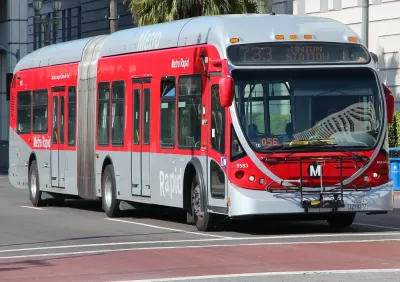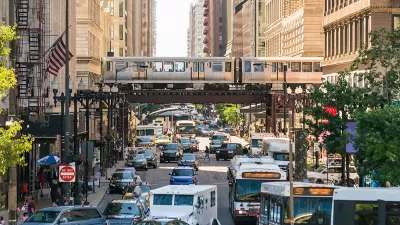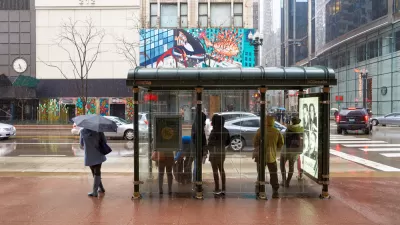Signal priority is a way to create faster, more regular bus service by adjusting length of stoplights for buses.

The signal priority system reportedly used in Los Angeles County should be a model for cities that want to speed up their public transit around the country, argues Kyle Ryan writes in Active Transportation Alliance. "Seventeen years ago, when Los Angeles County decided to give its buses priority at traffic signals, the buses experienced huge gains in speed and reliability," Ryan writes. The system senses buses coming to a stoplight and can adjust the length of red and green lights.
Cities like Chicago could use this type of system, not only to speed up public transit commutes, but also to space out buses more evenly. "Buses are dispatched every 3-10 minutes and can be instructed to slow down or speed up to avoid bunching with other buses," Ryan argues. This system means less waiting time at bus stops and shorter commute time, making transit more equitable for those not moving in cars.
FULL STORY: Los Angeles ‘signals’ the way to better bus service

Study: Maui’s Plan to Convert Vacation Rentals to Long-Term Housing Could Cause Nearly $1 Billion Economic Loss
The plan would reduce visitor accommodation by 25,% resulting in 1,900 jobs lost.

North Texas Transit Leaders Tout Benefits of TOD for Growing Region
At a summit focused on transit-oriented development, policymakers discussed how North Texas’ expanded light rail system can serve as a tool for economic growth.

Why Should We Subsidize Public Transportation?
Many public transit agencies face financial stress due to rising costs, declining fare revenue, and declining subsidies. Transit advocates must provide a strong business case for increasing public transit funding.

How to Make US Trains Faster
Changes to boarding platforms and a switch to electric trains could improve U.S. passenger rail service without the added cost of high-speed rail.

Columbia’s Revitalized ‘Loop’ Is a Hub for Local Entrepreneurs
A focus on small businesses is helping a commercial corridor in Columbia, Missouri thrive.

Invasive Insect Threatens Minnesota’s Ash Forests
The Emerald Ash Borer is a rapidly spreading invasive pest threatening Minnesota’s ash trees, and homeowners are encouraged to plant diverse replacement species, avoid moving ash firewood, and monitor for signs of infestation.
Urban Design for Planners 1: Software Tools
This six-course series explores essential urban design concepts using open source software and equips planners with the tools they need to participate fully in the urban design process.
Planning for Universal Design
Learn the tools for implementing Universal Design in planning regulations.
Ascent Environmental
Borough of Carlisle
Institute for Housing and Urban Development Studies (IHS)
City of Grandview
Harvard GSD Executive Education
Toledo-Lucas County Plan Commissions
Salt Lake City
NYU Wagner Graduate School of Public Service





























